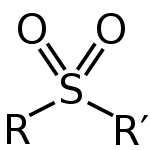Sulfone


A sulfone is a chemical compound containing a sulfonyl functional group attached to two carbon atoms. The central hexavalent sulfur atom is double bonded to each of two oxygen atoms and has a single bond to each of two carbon atoms, usually in two separate hydrocarbon substituents.[1]
Synthesis
Thioethers, often referred to as sulfides, are often the precursors to sulfones by organic oxidation through the intermediate formation of sulfoxides. For example, dimethyl sulfide is oxidized to dimethyl sulfoxide and then to dimethyl sulfone.[1] In the Ramberg-Bäcklund Reaction and the Julia olefination sulfones are converted to alkenes through the elimination of sulfur dioxide.[2]
The industrially useful sulfone is sulfolane, a cyclic molecule with the formula (CH2)4SO2. It is typically prepared, not by oxidation of the thioether, but by addition of sulfur dioxide to 1,3-butadiene, followed by hydrogenation of the resulting sulfolene.[3]
Sulfonylation
Under conditions for Friedel–Crafts reactions, arenes react with sulfonyl halides and sulfonic acid anhydrides affording sulfones. Common catalysts include AlCl3, FeCl3, GaCl3, BF3, SbCl5, BiCl3, and Bi(OTf)3, among others.[4][5] Intramolecular Friedel–Crafts cyclization occurs with 2-phenyl-1-ethanesulfonyl chloride, 3-phenyl-1-propanesulfonyl chloride and 4-phenyl-1-butanesulfonyl chloride on heating in nitrobenzene with AlCl3.[6] Sulfenyl and sulfinyl chlorides also undergo Friedel–Crafts–type reactions, affording sulfides and sulfoxides, respectively.[7]
Applications
Solvents
Sulfolane is used to extract valuable aromatic compounds from petroleum.[3]
Polymers
Some polymers containing sulfone groups have gained prominence in the field of engineering plastics. Various materials exhibit high strength and resistance to oxidation, corrosion, high temperatures, and creep under stress. For example, some are valuable as replacements for copper in domestic hot water plumbing.[8] Precursors to such polymers are the sulfones bisphenol S and 4,4′-dichlorodiphenyl sulfone.
Pharmacology
Examples of sulfones in pharmacology include dapsone, a drug formerly used as an antibiotic to treat leprosy, dermatitis herpetiformis, tuberculosis, or pneumocystis pneumonia (PCP). Several of its derivatives, such as promin, have similarly been studied or actually been applied in medicine, but in general sulfones are of far less prominence in pharmacology than for example the sulfonamides.[9][10]
Nomenclature
In the literature, particularly lay literature, sulfones commonly are confused with sulfonamides, though the latter have one carbon and one nitrogen atom attached to the sulfur atom, instead of two carbon atoms. The pharmacological mechanisms accordingly differ from that of the sulfonamides. However, in practice one commonly sees frequent references to dapsone and promin as sulfonamides. Probably this is partly because few pharmaceuticals are in fact sulfones. The use of the long-standing alternative spelling sulphone is discouraged by IUPAC; it is definitely undesirable to have two spellings in simultaneous common use, and it was agreed to discontinue the ph spelling as the more archaic.
Selenones
Selenketones and tellurones are the selenium and tellurium versions of the sulfones, though they are more reactive.
See also
- Organosulfur chemistry
- Sulfonanilide
- Sulfoxide
- Sulfonic acid (–OH substituent)
References
| Wikimedia Commons has media related to Sulfones. |
- 1 2 Hornback, Joseph (2006). Organic Chemistry. Australia: Thomson Brooks/Cole. ISBN 978-0-534-38951-2.
- ↑ Carey, Francis A.; Sundberg, Richard J. (2007). Advanced Organic Chemistry. Berlin: Springer. ISBN 978-0-387-68354-6.
- 1 2 Folkins, Hillis O. (2005). "Benzene". Ullmann’s Encyclopedia of Industrial Chemistry. Weinheim: Wiley-VCH. doi:10.1002/14356007.a03_475.
- ↑ Truce, W. E.; Vriesen; C. W. (1953). "Friedel—Crafts Reactions of Methanesulfonyl Chloride with Benzene and Certain Substituted Benzenes". J. Am. Chem. Soc. 75 (20): 5032–5036. doi:10.1021/ja01116a043.
- ↑ Répichet, S.; Le Roux, C.; Hernandez, P.; Dubac, J.; Desmurs, J. R. (1999). "Bismuth(III) Trifluoromethanesulfonate: An Efficient Catalyst for the Sulfonylation of Arenes". The Journal of Organic Chemistry. 64 (17): 6479–6482. doi:10.1021/jo9902603.
- ↑ Truce, W. E.; Milionis, J. P. (1952). "Friedel-Crafts Cyclization of ω-Phenylalkanesulfonyl Chlorides". J. Am. Chem. Soc. 74 (4): 974–977. doi:10.1021/ja01124a031.
- ↑ Fujisawa, T.; Kakutani, M.; Kobayashi, N. (1973). "On the Reaction of p-Toluenesulfinyl Chloride with Anisole". Bull. Chem. Soc. Jpn. 46 (11): 3615–3617. doi:10.1246/bcsj.46.3615.
- ↑ Fink, Johannes (2008). High Performance Polymers. Norwich: William Andrew. ISBN 978-0-8155-1580-7.
- ↑ Craig, Charles R.; Stitzel, Robert E. (2004). Modern Pharmacology with Clinical Applications. Hagerstwon: Lippincott Williams & Wilkins. ISBN 978-0-7817-3762-3.
- ↑ Drill, Victor Alexander; Di Palma, Joseph R. (1971). Drill's Pharmacology in Medicine. New York: McGraw-Hill. ISBN 978-0-07-017006-3.